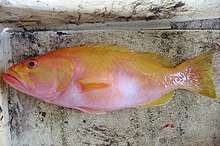Golden grouper
The golden grouper (Saloptia powelli), also known as the pink grouper or Powell's grouper, is a species of marine ray-finned fish, a grouper from the subfamily Epinephelinae which is part of the family Serranidae, which also includes the anthias and sea basses. It is found in the eastern Indian Ocean and Western Pacific Ocean.
| Golden grouper | |
|---|---|
 | |
| Scientific classification | |
| Kingdom: | Animalia |
| Phylum: | Chordata |
| Class: | Actinopterygii |
| Order: | Perciformes |
| Family: | Serranidae |
| Subfamily: | Epinephelinae |
| Tribe: | Epinephelini |
| Genus: | Saloptia J.L.B. Smith, 1964 |
| Species: | S. powelli |
| Binomial name | |
| Saloptia powelli J.L.B. Smith, 1964 | |
| Synonyms[2] | |
|
Plectropomus powelli (J.L.B. Smith, 1964) | |
Description
The golden grouper has a robust, oblong body and its depth is 2.6 to 3.1 times its standard length. The dorsal profile of the head is convex while the intraorbital area is flat. The preopercle is not smoothly rounded, but is not sharply angled, and has 3 large curved spines on its lower edge and very small serrations at its angle. The preopercular spines are mostly covered in skin. The gill cover has a markedly convex upper edge.[3] The dorsal fin contains 8 spines and 8 soft rays while the anal fin contains 3 spines and 8 soft rays.[4] The caudal fin is emarginate. The head, body, and fins are yellow to orange-yellow, shading on the underparts to white or pink. The snout, lips and opper portion of the head are tinted with red and the spines in the dorsal fin are occasionally marked with red streaks.[3] This species attains a maximum recorded total length of 39 centimetres (15 in).[4]
Distribution
The golden grouper is found in the eastern Indian Ocean and the Western Pacific Ocean from Christmas Island and the South China Sea east to French Polynesia, north to Taiwan and Okinawa south as far as the Great Barrier Reef.[1]
Habitat and biology
The golden grouper is a rariphotic[5] species which inhabits a depth range of 100 to 200 metres (330 to 660 ft),[1] where it occurs over rocky substrates.[4]
Utilisation
The golden grouper is an uncommon species but it is regarded as an important food fish in the Ryukyu Islands of southern Japan. In the Marianas it is one of the most commonly landed deep water grouper species.[3] It is caught using hand lines and drop lines.[1]
Taxonomy
The golden grouper was first formally described in 1964 by the South African ichthyologist James Leonard Brierley Smith (1897-1968) with the type locality given as the Cook Islands.[6] Smith stated that it was closely related to the groupers in the genus Plectropomus but differs in its dentition and in the greater rigidity of the spines in its dorsal and anal fins and created the monotypic genus Saloptia for it.[7] However, other authorities place this species within the genus Plectropomus but as well as the physical differences this species of the oceanic "twilight zone" has a different habitat preference to the shallow water coral groupers,[5] although its place within Plectropomus has been suggested by molecular studies.[2]
References
- Russell, B. (2018). "Saloptia powelli". IUCN Red List of Threatened Species. 2018: e.T132816A100572153. doi:10.2305/IUCN.UK.2018-2.RLTS.T132816A100572153.en. Retrieved 2 August 2020.
- Bray, D.J. (2018). "Saloptia powelli". Fishes of Australia. Museums Victoria. Retrieved 2 Aug 2020.
- Heemstra, P.C. & J.E. Randall (1993). FAO Species Catalogue. Vol. 16. Groupers of the world (family Serranidae, subfamily Epinephelinae). An annotated and illustrated catalogue of the grouper, rockcod, hind, coral grouper and lyretail species known to date (PDF). FAO Fish. Synopsis. 125 (16). FAO, Rome. p. 299-300. ISBN 92-5-103125-8.
- Froese, Rainer and Pauly, Daniel, eds. (2019). "Saloptia powelli" in FishBase. December 2019 version.
- Joe Rowlett (2018). "= Meet the new Groupers, Same as the old Groupers". Reefs.com. Retrieved 12 August 2020.
- Eschmeyer, W. N.; R. Fricke & R. van der Laan (eds.). "Saloptia powelli". Catalog of Fishes. California Academy of Sciences. Retrieved 12 August 2020.
- J.L.B. Smith (1964). "A new Serranid fish from deep water off Cook Island, Pacific". Annals and Magazine of Natural History (Series 13). 6 (72): 719–720. doi:10.1080/00222936308651421.
